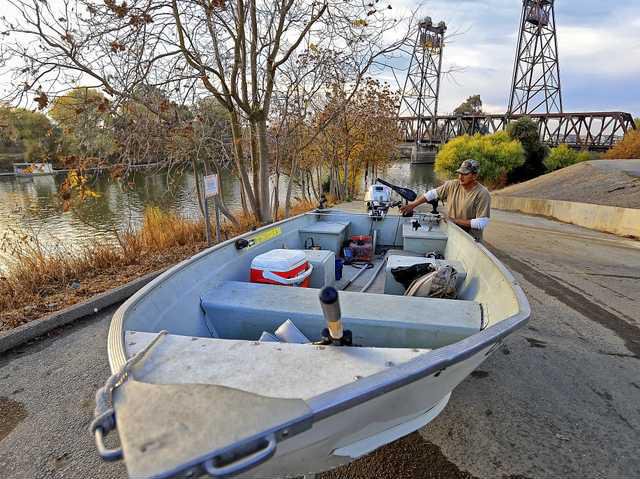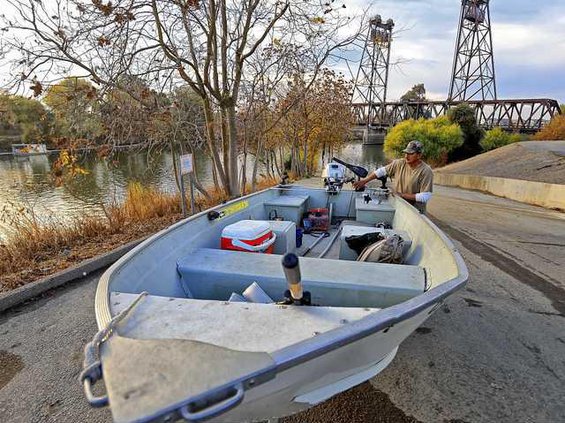A solution to protect more than 265,000 San Joaquin County residents against the ravages of a 200-year-flood is at least a decade away from being approved.
The solution that creates a safety valve by widening Paradise Cut to the south from where it branches off the San Joaquin River and passes beneath Interstate 5 just north of the Interstate 205 interchange to where it connects with the Old River.
It is an idea that has been floating around the state Department of Water Resources since the 1980s.
The Lower San Joaquin River Flood Bypass Proposal was formally submitted to the California Department of Water Resources in March 2011 by the South Delta Levee Protection and Channel Maintenance Authority and other partners. It was an effort to secure $5 million to create the new flood bypass in the last corridor of undeveloped land between Tracy and Lathrop.
It was included in 2012 as part of the department’s Central Valley Flood Protection Plan. Modeling shows if the seven-mile long Paradise Cut was widened by 1,000 feet to the south, it would lower water levels at Stockton, French Camp, and Lathrop by two feet to enhance 200-year flood protection by directing some water to the south Delta and away from downstream levees.
Engineers determined expanding the Paradise Cut would reduce flood stages significantly at Mossdale Crossing — 1.8 feet under a 50-year event as well as under a 100-year event such as the 1997 flood that inundated 70 square miles between Manteca and Tracy and caused property losses in excess of $80 million.
The review of that project by the Army Corps of Engineers is separate from the River Islands effort to add 200 acres on the north side of the envisioned bypass as part of the development of the 11,000-home planned community.
The River Islands project is based on a proposal made years ago that resurfaced in 2001 in an Army Corps of Engineers report to create a river bypass to reduce the potential for flooding in Manteca, Lathrop, and Stockton.
When Cambay Group — the developers of River Islands — filed for a permit with the Army Corps of Engineers in 2003 to modify Paradise Cut, they were told the review process would take 18 months. Fourteen years later the Army Corps still has not wrapped up its review. Cambay Group set aside $700,000 for land acquisition and agreed to spend money to do the necessary work that was pegged at between $1.8 million and $3 million six years ago
River Islands Project Manager Susan Dell’Osso is hopeful that once Trump’s nominee to serve as the Assistant Secretary of the Army for Civil Works, Rickey Dale James, is in place, the approval process for the 2001 application for Paradise Cut will move forward.
At the same time, it is still a decade away before the substantial widening of Paradise Cut to the south will wind its way through the review process.
Dell’Osso said River Islands is involved in both endeavors in an effort to be a good neighbor and steward of natural resources.
The Paradise Cut bypass has been embraced by environmental groups as it would allow for the restoration of habitat.
The Paradise Cut project is independent of efforts to secure 200-year flood protection for lands and cities on the eastside of the San Joaquin River from Lathrop/Manteca to Stockton but it would enhance those efforts. The levee work needed has been pegged at more than $160 million.
David Kennedy, the longest serving director of the Department of Water Recourses, in 1998 wrote the following about the Paradise Cut bypass proposal in the forward of the second edition of “Battling the Inland Sea”: “Recognizing the futility of simply raising the levees, flood control experts will now evaluate the feasibility of removing levees in some locations and simply letting future flood flows pond onto adjacent lands. Further, consideration is being given to opening up some form of bypass through the south Delta to relive pressure on the levees as the San Joaquin River flows into the Delta. It is hoped these issues will be resolved and changes will be made before the next flood.”
Government gave RD-17
levees split decision in 2010
Reclamation District 17 oversees the levees from a point midway between Mossdale and the San Joaquin River’s confluence with the Stanislaus River to French Camp Slough on the northern edge of Weston Ranch. That is the key reclamation district that protects Lathrop, Weston Ranch, and parts of southwest Manteca. It also involves where the river bends at Mossdale where water pressure pounds the levees.
The federal government in 2010 gave a split decision to the effectiveness of the Reclamation District levees. The Federal Emergency Management Agency granted the levees 100-year flood accreditation a week after the Army Corps of Engineers said RD-17 was among seven of the 10 Central Valley levees they inspected did not meet federal safety criteria and could be threatened in a flood or storm. The Corps conducts Central Valley levee system inspections every five years with engineers literally walking them.
It was the same year RD-17 was awarded $62.4 million in state bond money to strengthen levees.
The work funded was designed to maintain protection against a 100-year flood event and go a long way towards 200-year protection. The 100-year and 200-year monikers are a bit misleading as they are described as flooding that has a chance of happening every 100 years based on natural conditions. As more valley soil has been paved or built on run-off has increased significantly reducing the times between major flooding.
The money was wedded with $1 million raised from a $37 parcel tax assessment over five years that a majority of 4,000 home owners in Lathrop, Weston Ranch, and the extreme southwest edge of Manteca voted to put in place. The parcel tax made it possible to secure the state bond money.
The parcel tax also allowed the district to secure a $10 million U.S. Army Corps of Engineers grant to improve flood protection for a large swath of land generally west of Interstate 5 from Mossdale north to Weston Ranch and a large chunk of the developed portion of the City of Lathrop.
The work involved building a series of berms next to 21 crucial spots in the levees. The 50-foot long by 4-foot high berms serve to strengthen the levees if water manages to seep through.
River Islands at Lathrop resolved their flood concerns by creating 300-foot wide levees at a cost of $70 million to take 900 acres on Stewart Tract out of the floodplain.
In addition River Islands spent $2 million on studies to prove to the state that the levees created in 2006 provide 200-year flood projection as mandated by Senate Bill 5.
The last floods were in 1997 when roughly a dozen breaks along the San Joaquin and Stanislaus rivers ended up flooding 70 square miles, damaging more than 800 structures, forcing 2,000 people to flee, and ultimately caused $80 million worth of damages.
The Army Corps of Engineers spent $2 million to patch the existing levees after the 1997 flooding to restore them to the same condition they were in prior to the failure.
The biggest recorded flood in modern South County history started in 1950. It caused flooding west of present-day Interstate 5 in Lathrop. Flood waters threatened San Joaquin County Hospital and came within four miles of downtown Manteca. There were 2,000 people evacuated. Today, if the same flooding occurred, it would force 40,000 people to flee.
To contact Dennis Wyatt, email dwyatt@mantecabulletin.com
Still waiting on Paradise
Army Corps stretches 18-month approval into 14 year plus odyssey



